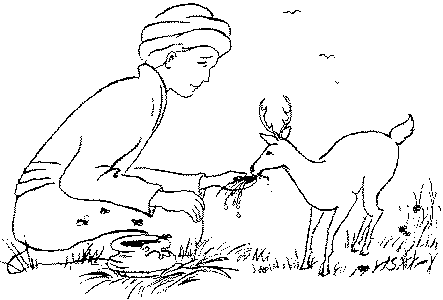
The Wind-deer and the Honey-grass [The Craving for Taste]
Once upon a time, the King of Benares had a gardener who looked after his pleasure garden. Animals sometimes came into the garden from the nearby forest. The gardener complained about this to the king, who said, “If you see any strange animal, tell me at once.”
One day, he saw a strange kind of deer at the far end of the garden. When he saw the man, he ran like the wind. That is why they are called ‘wind-deer’. They are a rare breed, that are extremely timid. They are very easily frightened by human beings.
The gardener told the king about the wind-deer. He asked the gardener if he could catch the rare animal. He replied, “My lord, if you give me some bee’s honey, I could even bring him into the palace!” So the king ordered that he be given as much bee’s honey as he wanted.
This particular wind-deer loved to eat the flowers and fruits in the king’s pleasure garden. The gardener let himself be seen by him little by little, so he would be less frightened. Then he began to smear honey on the grass where the wind-deer usually came to eat. Sure enough, the deer began eating the honey-smeared grass. Soon he developed a craving for the taste of this ‘honey-grass’. The craving made him come to the garden every day. Before long, he would eat nothing else!
Little by little, the gardener came closer and closer to the wind-deer. At first, he would run away. But later, he lost his fear and came to think the man was harmless. As the gardener became more and more friendly, eventually he got the deer to eat the honey-grass right out of his hand. He continued doing this for some time, in order to build up his confidence and trust.

Meanwhile, the gardener had rows of curtains set up, making a wide pathway from the far end of the pleasure garden to the king’s palace. From inside this pathway, the curtains would keep the wind-deer from seeing any people that might scare him.
When all was prepared, the gardener took a bag of grass and a container of honey with him. Again he began hand-feeding the wind-deer when he appeared. Gradually, he led the wind-deer into the curtained-off pathway. Slowly, he continued to lead him with the honey-grass, until finally the deer followed him right into the palace. Once inside, the palace guards closed the doors, and the wind-deer was trapped. Seeing the people of the court, he suddenly became very frightened and began running around, madly trying to escape.
The king came down to the hall and saw the panic-stricken wind-deer. He said, “What a wind-deer! How could he have gotten into such a state? A wind-deer is an animal who will not return to a place where he has so much as seen a human, for seven full days. Ordinarily, if a wind-deer is at all frightened in a particular place, he will not return for the whole rest of his life! But look! Even such a shy wild creature can be enslaved by his craving for the taste of something sweet. Then he can be lured into the center of the city and even inside the palace itself.
“My friends, the teachers warn us not to be too attached to the place we live, for all things pass away. They say that being too attached to a small circle of friends is confining and restricts a broad outlook. But see how much more dangerous is the simple craving for a sweet flavour, or any other taste sensation. See how this beautiful shy animal was trapped by my gardener, by taking advantage of his craving for taste.”
Not wishing to harm the gentle wind-deer, the king had him released into the forest. He never returned to the royal pleasure garden, and he never missed the taste of honey-grass.
The moral is: “It is better to eat to live, than to live to eat.”

